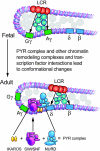Regulation of human fetal hemoglobin: new players, new complexities
- PMID: 16109777
- PMCID: PMC1895603
- DOI: 10.1182/blood-2005-05-2113
Regulation of human fetal hemoglobin: new players, new complexities
Abstract
The human globin genes are among the most extensively characterized in the human genome, yet the details of the molecular events regulating normal human hemoglobin switching and the potential reactivation of fetal hemoglobin in adult hematopoietic cells remain elusive. Recent discoveries demonstrate physical interactions between the beta locus control region and the downstream structural gamma- and beta-globin genes, and with transcription factors and chromatin remodeling complexes. These interactions all play roles in globin gene expression and globin switching at the human beta-globin locus. If the molecular events in hemoglobin switching were better understood and fetal hemoglobin could be more fully reactivated in adult cells, the insights obtained might lead to new approaches to the therapy of sickle cell disease and beta thalassemia by identifying specific new targets for molecular therapies.
Figures



References
-
- Bank A, Mears JG, Ramirez F. Disorders of human hemoglobin. Science. 1980;207: 486-493. - PubMed
-
- Stamatoyannopoulos G, Grosveld F. Hemoglobin switching. In: Stamatoyannopoulos G, Majerus PW, Perlmutter RM, Varmus H, eds. The Molecular Basis of Blood Disease. 3rd ed. Philadelphia, PA: Saunders; 2001: 135-183.
-
- Grosveld F, van Assendelft GB, Greaves DR, Kollias G. Position-independent, high-level expression of the human β-globin gene in transgenic mice. Cell. 1987;51: 975-985. - PubMed
Publication types
MeSH terms
Substances
Grants and funding
LinkOut - more resources
Full Text Sources
Other Literature Sources

